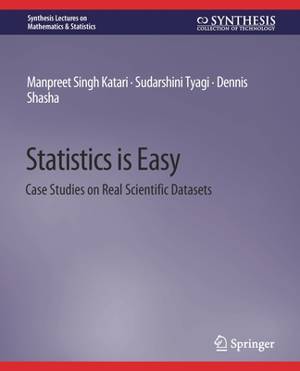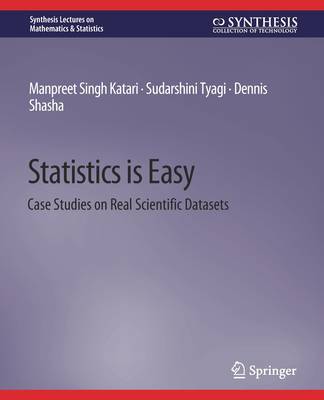
Je cadeautjes zeker op tijd in huis hebben voor de feestdagen? Kom langs in onze winkels en vind het perfecte geschenk!
- Afhalen na 1 uur in een winkel met voorraad
- Gratis thuislevering in België vanaf € 30
- Ruim aanbod met 7 miljoen producten
Je cadeautjes zeker op tijd in huis hebben voor de feestdagen? Kom langs in onze winkels en vind het perfecte geschenk!
- Afhalen na 1 uur in een winkel met voorraad
- Gratis thuislevering in België vanaf € 30
- Ruim aanbod met 7 miljoen producten
Zoeken
Statistics Is Easy
Case Studies on Real Scientific Datasets
Manpreet Singh Katari, Sudarshini Tyagi, Dennis Shasha
€ 35,45
+ 70 punten
Uitvoering
Omschrijving
Computational analysis of natural science experiments often confronts noisy data due to natural variability in environment or measurement. Drawing conclusions in the face of such noise entails a statistical analysis. Parametric statistical methods assume that the data is a sample from a population that can be characterized by a specific distribution (e.g., a normal distribution). When the assumption is true, parametric approaches can lead to high confidence predictions. However, in many cases particular distribution assumptions do not hold. In that case, assuming a distribution may yield false conclusions. The companion book Statistics is Easy, gave a (nearly) equation-free introduction to nonparametric (i.e., no distribution assumption) statistical methods. The present book applies data preparation, machine learning, and nonparametric statistics to three quite different life science datasets. We provide the code as applied to each dataset in both R and Python 3. We also include exercises for self-study or classroom use.
Specificaties
Betrokkenen
- Auteur(s):
- Uitgeverij:
Inhoud
- Aantal bladzijden:
- 62
- Taal:
- Engels
- Reeks:
Eigenschappen
- Productcode (EAN):
- 9783031013058
- Verschijningsdatum:
- 8/04/2021
- Uitvoering:
- Paperback
- Formaat:
- Trade paperback (VS)
- Afmetingen:
- 190 mm x 235 mm
- Gewicht:
- 145 g

Alleen bij Standaard Boekhandel
+ 70 punten op je klantenkaart van Standaard Boekhandel
Beoordelingen
We publiceren alleen reviews die voldoen aan de voorwaarden voor reviews. Bekijk onze voorwaarden voor reviews.









